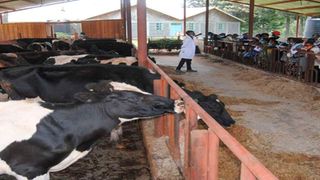
Raphael Mugo, the farm manager at Baraka Agriculture College in Molo, trains farmers during a field day last week. He asked farmers to grow their own fodder.
| John Njoroge | Nation Media GroupSeeds of Gold
Premium
How to make a livestock enterprise profitable
What you need to know:
- Many farmers, who produce milk under zero-grazing, do not keep production records.
- Often they end up selling the milk at prices lower or close to the production cost.
Most livestock production in the country is done by small-scale farmers. Majority of them keep the animals for their household food security.
The farmers sell the animals and products such as milk, wool and eggs in a non-programmed manner. Due to the large number of farmers selling small quantities of livestock and their products mainly to middlemen, the market demand tends to appear satisfied.
It also turns out that most farmers do not keep records of production costs. Therefore, any money they get from the sale of livestock and their products is taken to be profit. In fact, if the farmers actually did cost accounting of their model of livestock production, they would fold up immediately and invest their money and efforts elsewhere.
I am not in any way discouraging small-scale subsistence farmers from keeping livestock. I am only saying that it would be important for all livestock farmers to ensure that the animals they keep are beneficial to them not only socially but also financially because there is business in livestock farming.
For subsistence farmers keeping animals such as sheep, cattle, goats and chicken on farm pasture, the cost of production is fairly low. Further, the animal products provide a huge saving on the costs of buying animal proteins for household needs.
As we all know, animal proteins comprising meat, milk, eggs, cheese and ghee are quite expensive. I recall in my early years as a child, we did not have a single animal in our family and our nutrition was very poor. However, once the Ministry of Social Services trained our parents and other villagers on the value of subsistence livestock farming, they bought some cattle, sheep, goats and chicken under free range system.
Zero-grazing
We had more food than we needed including crop harvest; which was enhanced by the animals’ manure. We never went hungry again. The impact of those animals on my early life is one of the reasons why I chose to become a veterinary doctor.
Inevitably, due to the increase of population and continuous land subdivision to smaller units, free-range livestock farming has increasingly become untenable. Most subsistence farmers have resorted to farming under confinement, commonly referred to as zero-grazing. This is a very expensive form of farming for all species of animals because all the feed has either to be commercially produced or harvested and brought to the animals.
There is also the additional cost of cleaning for the animals and the increased need for health services. Animals in confinement tend to get sick more often than those on pasture because of the associated stress, imbalanced feeding and concentration of disease-causing organisms.
Livestock production on pasture in Kenya is now mainly left to pastoral communities or some areas where the population is still low. But even in these areas, the days of free-range farming are numbered as more children enrol and excel in education.
Such children rarely go back to pastoral life and the parents lack the labour required for managing the animals. One herder in Turkana told me in 2015 he was worried his herd would all disappear because he was getting old and his children had all gone to work in cities after he had educated them using the animals.
Now, the big question for confined farming is whether you could be making money for someone else with your livestock. Many farmers, who produce milk under zero-grazing, do not keep production records and eventually sell the milk at prices lower or close to the production cost.
Milk production
From my experience with various farmers, production cost for a litre of cow milk ranges from Sh10 for free-range farming to Sh26 for zero-grazing.
The best option in milk production is to minimise the costs by combining both commercial feeds and feeds produced on the farm. Further, the farmer should strive to sell her milk either directly to a cooperative, processor or consumers and avoid freelance or small-scale middlemen. Otherwise, she would be making losses while the traders make the kill.
Pigs and chickens are nowadays mostly farmed in confinement. For chicken, the birds are supplied as day-old from hatcheries. My experience is that most poultry farmers keep 100 to 500 birds, commonly broilers in one to three batches in a year. These numbers are far below the profitable stocking level of about 3,000 birds per lot in three to four lots per year.
It is, therefore, not surprising that it is difficult to get a poultry farmer who will give a 20-year history of broiler farming. Yet, the hatcheries keep going very strong and have many years of operation.
This is because the hatcheries always sell all their chick stocks to producers, who are operating on uneconomical scale. I always advise farmers to understand the economic production scale and enter into agreements with hatcheries to be supplied day-old chicks in economic numbers and frequency.
What really happens is that farmers operate at uneconomical scales. They make losses and exit poultry farming. The gap they leave creates a shortage in poultry meat supply. Other entrepreneurs notice and wade into poultry production and the cycle continues.





